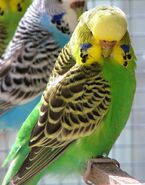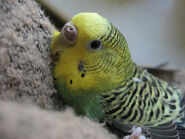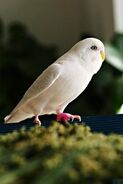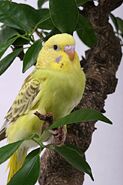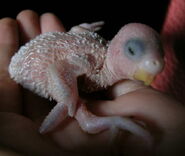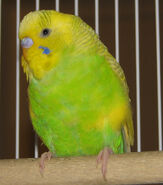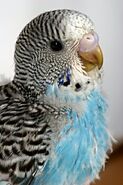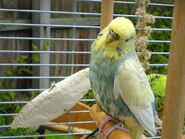Assessment |
Biopsychology |
Comparative |
Cognitive |
Developmental |
Language |
Individual differences |
Personality |
Philosophy |
Social |
Methods |
Statistics |
Clinical |
Educational |
Industrial |
Professional items |
World psychology |
Animals · Animal ethology · Comparative psychology · Animal models · Outline · Index
| ?Budgerigar Conservation status: Least concern[1] | ||||||||||||||||||
|---|---|---|---|---|---|---|---|---|---|---|---|---|---|---|---|---|---|---|
| Male Budgerigar of Wildtype (natural Green) coloration Male Budgerigar of Wildtype (natural Green) coloration
| ||||||||||||||||||
| Scientific classification | ||||||||||||||||||
| ||||||||||||||||||
| Melopsittacus undulatus (Shaw, 1805) |
The Budgerigar (Melopsittacus undulatus, nicknamed budgie), the only species in the Australian genus Melopsittacus, is a small parrot belonging to the tribe of the broad-tailed parrots (Platycercini); these are sometimes considered a subfamily (Platycercinae). In the latter case, the Budgerigar is sometimes isolated in a tribe of its own, the Melopsittacini, although it is probably quite closely related to Pezoporus and Neophema.[2] Though Budgerigars are often called Parakeets, especially in American English, this term refers to any of a number of small Parrots with long flat tails. The Budgerigar is found throughout the drier parts of Australia and has survived in the inlands of that continent for over 5 million years.[3]
Etymology[]
At least three possible origins for the English name Budgerigar have been proposed:
- A compound of budgery, "good" and gar "Cockatoo". Budgerigar means "good eating" or "good food" in some Australian Aboriginal languages.[4] This is supported by the Oxford English Dictionary. The word budgery itself, also spelt boojery, was formerly in use in Australian English slang meaning "good".
- An alteration of Gamilaraay gidjirrigaa (IPA: /ɡiɟiriɡaː/),[5] possibly influenced by the slang word budgery mentioned above. This is supported by the American Heritage Dictionary.
The genus name Melopsittacus comes from Greek and means "melodious parrot". The species name undulatus is Latin for "undulated" or "wave-patterned".
Characteristics[]
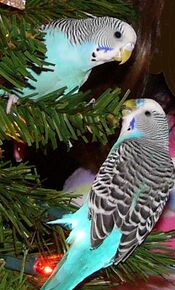
Adult females (left above) display beige to brown ceres while adult males (right above) typically have blue ceres or purplish-pink in Albinistic & recessive-pied varieties.
Appearance[]
Budgerigars are about 18 cm long and weigh 30-40 grams. Wild Budgerigars display a green body colour (abdomen and rumps), while their mantle (back & wing coverts) is black edged in yellow. The forehead and face is yellow in adults, and barred black with yellow in young till they change into their adult plumage at 3-4 months of age. Each cheek has a small dark purple patch (cheek patches) and a series of 3 black spots across each sides of their throats (throat-spots) of which the outermost spots are situated at the base of each cheek-patches. The tail is cobalt (dark-blue); outside tail feathers display central yellow flashes. Their wings have greenish-black flight feathers and black coverts with yellow fringes along with central yellow flashes which only becomes visible in flight &/or when the wings are stretched. Bill olive grey and legs blueish-grey, with zygodactyl toes.[6] Wild budgerigars are noticeably smaller than those in captivity. These parrots have been bred in many other colours in captivity, such as white, blue, and even purple, although they are mostly found in pet stores in blue, green and occasionally white. Budgerigar plumage is known to fluoresce under ultraviolet light, a phenomenon possibly related to courtship and mate selection.[7]
The colour of the cere (the area containing the nostrils) differs between the sexes; royal blue in males, pale-brown to white (non-breeding) or brown (breeding) in females and pink in immatures of both sexes (usually of a more even purplish-pink colour in young males). Young females can often be identified by a subtle chalky whiteness that starts around the cere nostril holes. Males that are either albino, lutino &/or recessive-pied (aka Danishpied aka Harlequin) always retain the immature purplish-pink cere color their entire life.[8][6]
Because birds have a ZW sex-determination system, sex-linked recessive traits are more common in females than in males, rather than the reverse as is found the more familiar XY determination of humans & other mammals.
Personality[]
Budgerigars are, very generally speaking, accepting of humans and other birds, but should never be housed with a bird other than another budgerigar. Care should be taken even when placing two budgies together, as they can do serious harm to one another if they do not get along. They are relatively easily tamed.
Bird lovers often comment on the differences in personality in each individual bird. Budgies each have their own unique ideas about how much they like to be handled, which toys are their favorites, and even what music they like or are indifferent to.
Habitat and behaviour[]
Budgerigars are nomadic birds found in open habitats, primarily in Australian scrubland, open woodland and grassland. The birds are normally found in small flocks, but can form very large flocks under favourable conditions. The species is extremely nomadic and the movement of the flocks is tied to the availability of food and water.[6] Drought can drive flocks into more wooded habitat or coastal areas. They feed on the seeds of spinifex, grass weeds, and sometimes ripening [wheat.[9].[6]
Breeding takes place generally between June and September in the North and between August and January in the South but they are opportunistic breeders responding to the rains when grass seeds become most abundant.[6] Populations in some areas have increased as a result of increased water availability at farms. The nest is in a hole in a tree, fence post or even a log laying on the ground; the 4-6 eggs are incubated for 17-19 days, with the young fledging about 30 days after hatching.[9][6]
Feral birds have been found since the 1940s in the St. Petersburg, Florida area of the United States, but are much less common than they were in the early 1980s. Colder than normal winter temperatures in some years and increased competition from European Starlings are the main reasons for the declining population.[10]
Audience effect[]
Male budgerigars,Melopsittacus undulatus, socially monogamous birds, actively pursue extra-pair copulations while breeding in captive flocks. Males are significantly more likely to engage in extra-pair activity when their mates are not able to observe their behaviour, and the evidence suggests that a male's frequency of extra-pair activity is negatively related to his mate's reproductive success, as measured by nestling weight and number of fledglings.
A second experiment was designed to separate an audience effect phenomenon from alternative explanations such as time conflicts with mate guarding. Males were given the opportunity to court an extra-pair female both when their mates were present as a potential audience and with no audience present. In both conditions, mates were isolated from both the flock and the test male, removing the need and the opportunity to guard. Males were still significantly more likely to court extra-pair females when their mates could not see them, supporting the audience effect interpretation. It is suggested that female budgerigars may use mate fidelity in assessing male parental qualities. If so, males that court extra-pair females only when their mates cannot observe may avoid weakening an existing pair bond.[11]
Captivity[]
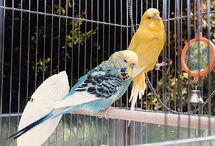
Pet budgerigars.
The Budgerigar is one of the two Parrots to be genuinely domesticated as a species along with the Peach-faced Lovebird (Agapornis roseicollis). Believed to be the most common pet Parrot in the world, the Budgerigar has been bred in captivity since the 1850s. Breeders have worked over the decades to produce a wide range of colour, pattern and feather mutations, such as blue, white, violet, olive, albino and lutino (yellow), pied, clearwing, spangled, and crested.
Modern show budgerigars, also called English budgerigars and/or Standard-Type Budgerigars are larger than their wild-type (natural form) counterparts, with puffy head feathers, giving them an exaggerated look. The eyes and beak can be almost totally obscured by feathers. Such birds are reported to be more prone to genetic mutations because of inbreeding. Most Budgerigars in the pet trade are not of the show variety (Standard-Type aka English Budgies) and are similar in size and body conformation to wild Budgerigars and thus aptly called wild-type Budgies.
Budgerigars are intelligent and social animals and enjoy the stimulation of toys and interaction with humans as well as with other Budgerigars. A common behaviour is the chewing of material such as wood, especially for female Budgerigars.
=Birdsong[]
Budgerigars can be taught to speak, whistle tunes, and play with humans. Both males and females sing and can learn to mimic sounds & words. Both singing and mimicry are more pronounced and much more perfected in males. As a whole, females rarely if ever learn to mimic more than a dozen words or so. Males can very easily acquire vocabularies ranging between a few dozen to a hundred words. Generally speaking, it is the pet Budgies and even more so the ones kept as single pets which talk the best and the most.
Template:Main Budgerigar - Birdsong
Although taste in toys varies from bird to bird, some toys which are universal favorites among pet budgies include:
- plastic balls, either light solid or hollow, perhaps with inside bell,
- bells,
- carousels,
- non-toxic chew-toys and fruit-tree branches,
- natural ropes such as hemp or sisal,
- natural (undyed and untreated) wood blocks and pieces,
- wooden sticks, like from lollys or coffee,
- ladders, either plastic or wooden and up to any length,
- mirrors, which are especially liked by solitary birds,
- plain brown cardboard and paper items such as small boxes and paper rolls,
- plastic olympic-ring toys,
- pieces of raffia,
- swings hung from high place or top of cage,
- whole or pieces of brown paper lunch-bags,
- natural (non-metal, undyed and untreated) woven baskets are suggested by many pet guides as the safest way to provide a play gym for small Parrot species.
In captivity, Budgerigars live an average of five to eight years, but are reported to occasionally live to 15 if well cared for.[12] The life span depends on the budgerigar's breed (show Budgerigars typically do not live as long as wild-type (natural sized) budgerigars) and the individual bird's health, which is highly influenced by exercise and diet.
Although wild Budgerigars eat grass seeds almost exclusively, avian veterinarians recommend supplementation with foods such as fresh fruits and vegetables, sprouted seeds, pasta, whole grain bread and other healthy human foods, as well as pellets formulated for small parrots. Adding these foods provides additional nutrients and can prevent obesity and lipomas, as can substituting millet, which is relatively low in fat, for seeds mixes. Budgerigars do not always adapt readily to dietary additions, however. Chocolate and avocado are recognized as potential toxins.[13]
All fruits except avocado are healthy but must always be offered without any included seeds.
All vegetables are healthy but both onions and potatoes must not be offered uncooked.
Legumes (aka Pulses) such as beans, lentils, and peas are usually preferred in their well-cooked or sprouted states (except for only lima & navy Beans which are toxic) but can offered in their dried state as well.
Commercial or well-rinsed wild non-toxic edible blossoms, flowers and greens (i.e. daisies, dandelion's leaves and flowers, fruit-tree blossoms, herb blossoms, hibiscus, nasturtiums, pansies, passiflorae, roses, sunflowers, tulips and more) are also very healthy.
Cooked cereals such as barley, oatmeal, quinoa, whole-grain pastas, whole-grain waffles, whole or wild rices are all very healthy.
Sprouted seeds (one can sprout typical Budgerigar seed mix which will sprout whenever the seeds are fresh) are also healthy & highly nutritious.
Reproduction[]
The male will stand on female's back while some beak contact is made between the mates. The male will then wrap his tail under the female's raised tail, place his cloaca (male birds have no penis) against hers and rub it back and forth to stimulate ejaculation. The male may move away for a moment before returning for another session.
Breeding[]
Budgerigars are easily bred. In the wild, virtually all Parrot species require a hollow tree or a hollow log and because of they naturally require nest-boxes for breeding. A hen will lay her eggs on alternate days; after the first one, there is usually a two-day gap until the next. She will usually lay between four to twelve eggs, which she will incubate (usually starting after laying her 2nd or 3rd) for about 19 days each. Depending on the clutch size, there can be between be anywhere from 5 to 15 day age difference between the first and last hatchlings.
When the eggs start to hatch, the hatchlings are usually very helpless. During the second or third week, the chick's eyes will open, and they will start to develop feather down which typically indicates best-time for close-banding the chicks. They develop feathers and thus their colour mutation will be quite obvious around 3 weeks of age.
By the fifth week, the chicks are strong enough that the parents will be comfortable in staying more and more out of the nest. The youngsters will stretch their wings to gain strength before they attempt to fly. They will also help defend the box from enemies. Young Budgerigars typically fledge (leave nest) around their fifth week of age and are usually completely wheaned a week later. However, the age for fledging as well as wheaning can vary slightly depending on wether it is the oldest, the youngest &/or the only surviving chick. Generally speaking, the oldest chick is the first to be wheaned. But even though it is logically the last one to be wheaned, the youngest chick often whean itself at a younger age then it's older sibbling(s) and this from following and/or mimicking it's sibblings. Consequently, lonely surviving chicks usually are wheaned at the youngest age from having their parent's full attention & care.
Breeding difficulties[]
Breeding difficulties arise for various reasons. Some chicks may die from diseases or attacks by their parents. Other budgerigars may fight over the nest box, attacking the hen while she is laying her eggs. Other difficulties can involve inbreeding Another problem may be the birds' beak being underlapped. This is where the lower mandible is above the upper mandible.
Human speech[]
A budgerigar named Puck holds the world record for the largest vocabulary of any bird, at 1,728 words. Puck, owned by American Camille Jordan, died in 1994, with the record first appearing in the 1995 edition of Guinness World Records.[14][15]
The budgerigar will typically speak words in the context to which he or she is accustomed to hearing them. For example, if the bird owner says "up" every time the bird is picked up, the bird may say "up" when it is picked up, or wants to be picked up.
Many budgerigars prefer non-verbal communication, such as stomping on their food dish and shrieking when they want fresh seed, rather than asking for it.
Gallery[]
See also[]
Budgerigar colour genetics
References[]
- ↑ BirdLife International (2004). Melopsittacus undulatus. 2006 IUCN Red List of Threatened Species. IUCN 2006. Retrieved on 11 May 2006. Database entry includes justification for why this species is of least concern
- ↑ Mol. Biol. Evol. 15(5):544–551. (1998)
- ↑ Dr. Marshall's Philosophy on Breeding Exhibition Budgerigars. Bird Health. URL accessed on 2007-01-19.
- ↑ Online etymology dictionary
- ↑ A Reference Dictionary of Gamilaraay
- ↑ 6.0 6.1 6.2 6.3 6.4 6.5 Forshaw, Joseph Michael; William T. Cooper (1973 & 1981). Parrots of the World, 1st and 2nd. ISBN 0-87666-959-3.
- ↑ S M Pearn, A T Bennett, and I C Cuthill (2001). Ultraviolet vision, fluorescence and mate choice in a parrot, the budgerigar Melopsittacus undulatus.. URL accessed on 7 May, 2007.
- ↑ Birds Online - How to tell the sex of a budgie. URL accessed on 25 April, 2006.
- ↑ 9.0 9.1 The Wild Budgerigar. (article) URL accessed on 25 April, 2006.
- ↑ Pranty, Bill Budgerigar: Melopsittacus undulatus. Florida's Breeding Bird Atlas. URL accessed on 2006-12-28.
- ↑ BALTZf, ALIZA P, ANNE B. CLARK (May 1997). Extra-pair courtship behaviour of male budgerigars and the effect of an audience. Department of Biological Sciences, Binghamton University 53 (5): 1017–1024.
- ↑ Birds Online - Life span of a budgie. URL accessed on 26 December, 2005.
- ↑ Margaret A. Wissman, D.V.M., D.A.B.V.P.. Medical Conditions and Diseases of the Budgerigar and Cockatiel. (article) ExoticPetVet.Net. URL accessed on 26 April, 2006.
- ↑ Claire Folkard (ed.) Guinness World Records 2004, p. 54, Guinness World Records Limited.
- ↑ The Bird with the Largest Vocabulary in the World. URL accessed on 2007-01-06.
External links[]
- A True Ambassador: the Budgerigar Referenced article on budgerigars
- List of Plants & Branches Hazardous to Birds Referenced list oriented toward pet birds
- Common Budgie Mutations Illustrated list of common budgerigar mutations
Template:Pet Species
| This page uses Creative Commons Licensed content from Wikipedia (view authors). |
